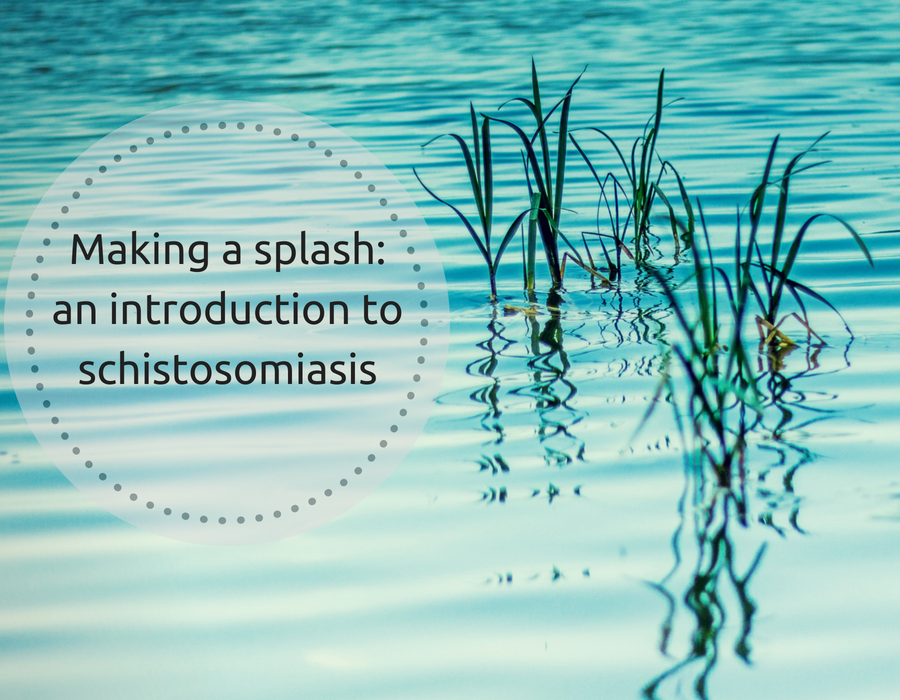Roisin Conneely
Summer is well and truly upon us, and if your summer holidays take you to anywhere with fresh water that you might be tempted to jump into, you might want to get clued up on a parasite you’ll want to avoid…
Schistosomiasis is classified as a neglected tropical disease (NTD) and is caused by schistosomes, otherwise known as flat worms. The parasite is transmitted by freshwater snails, so any contact with freshwater in risk areas is potentially dangerous. The disease is sometimes referred to as biliharzia or snail fever.
Three species of schistosomes are responsible for most human cases of the disease; S. mansoni, S. haematobium and S. japonicum. Two other species, S. intercalatum and S. mekongi can also cause human infection, but not on such a large scale.

Epidemiology
The parasite is found in tropical climates, with 74 developing countries identifying epidemics in 2009. The disease is prevalent across Africa,found in freshwater in southern and sub-Saharan Africa. It can also be transmitted via the Nile River valley in Sudan and Egypt. The parasite can also be found in South America, particularly in countries such as Brazil and Venezuela. It is estimated that 200,000 people die annually due to schistosomiasis, with the disease affecting 238 million people a year, 85% of whom live in Africa. Furthermore, 600-700 million people worldwide are living in risk areas
Adult worms are less than 2cm long and can live for between three and five years. They are unique amongst trematodes, being dioecious with distinct sexual dimorphism (most trematodes are simultaneous hermaphrodites). The parasites, once inside a host, live in the veins around the bladder (S. haematobium), or in the mesenteric blood vessels (S. mansoni and S. japonicum). S. haematobium will therefore be excreted in the urine, whilst S. mansoni and S. japonicum are released in the faeces.

The disease primarily affects children below the age of 14, as they tend to spend more time playing in water, but of course, it’s not exclusively a children’s disease. There is also a link between schistosomiasis and poverty, being a disease that tends to be more prevalent in developing countries. A paper by Charles H. King published in Acta Tropica in 2009, describes the disease as a “disability tax” on inhabitants of schistosomiasis-endemic regions. The infection can be viewed as both an effect of, and a cause of poverty, as the long term burden of the disease can lead to malnutrition and poor school and work performance, which all contribute to the vicious cycle of continued poverty.
Schistosomiasis has been so common in Egypt throughout history that the subsequent haematuria (blood in urine) was viewed as a type of male menstruation and was believed to be a rite of passage for boys. Although the link between water and the onset of bleeding was known, it wasn’t until the 20th century that knowledge of the disease and its transmission became more widespread throughout the country.
Symptoms
Many people are asymptomatic, or won’t present symptoms for months or years following infection. One of the tell-tale signs of infection is a tingling sensation or slight rash within 12 hours of transmission, this is known as “swimmers itch”.
Symptoms, if they do appear, can occur 4-6 weeks after infection, and may include:
- Fever or chills
- Cough
- Diarrhoea
- Muscle or joint pain
These are symptoms of the acute forms of the disease, also known as Katayamas fever, and are often self-limiting, meaning they get better within a few weeks. However, sometimes schistosomiasis can become chronic, and extremely dangerous.
Abdominal pain and swelling, blood in the urine, and pain when urinating are some of the first indicators of chronic infection.

Hepatosplenomegaly; the enlargement of the liver and spleen, is a major complication of the disease. This can lead to oesophageal varices; dilated sub-mucosal veins in the lower third of the oesophagus, which have a tendency to bleed easily.
Years of untreated infection can cause granulomas and fibrosis in the affected organs, which can have knock on effects such as hypertension, colonic polyps (abnormal tissue growth projecting from a mucous membrane), glomerulonephritis (inflammation of the glomeruli of the kidneys), as well as the symptoms mentioned above.
Long-term schistosomiasis can also lead to calcification of the bladder wall, which may eventually lead to bladder cancer in some cases. Once eggs colonise the urinary system, they can then travel to the genitalia, which can lead to infertility in some cases. Chronic schistosomiasis is also often a major cause of anaemia, especially in children, thus, it’s easy to see how this disease can wreck entire communities.
Rarely, schistosome eggs can travel to the brain and spinal cord via embolization. They can become lodged, leading to inflammation, seizures and even paralysis. Lesions caused by the granulomas in the spinal cord can cause transverse myelitis (inflammation), leading to flaccid paraplegia; a loss of motor function in the lower extremities. These neurological complications are more common in S. japonicum infection, but are also increasingly being observed in S. mansoni cases.

So, how can such symptoms be detected and treated? And how exactly does this sneaky little worm cause all this damage? We’ll be exploring schistosomiasis further in next week’s post, so stay tuned!
References:





Snail’s pace: schistosomiasis part 2 – Seeking Science
[…] Last week, we introduced you to a worm you probably don’t ever want a real-life introduction to, the parasite behind the neglected tropical disease, schistosomiasis. Now, let’s dive in to the life cycle of this critter, how it enters the body and what damage it does there, and how the disease may be detected and treated. […]
Mab
Very informative, thank you! Didn’t know about that disease at all!